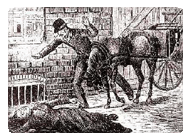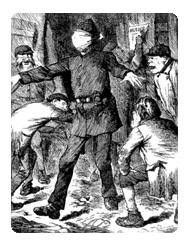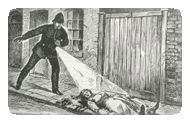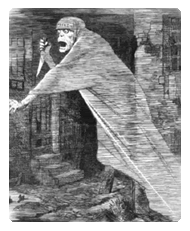Friday, June 06, 2008
Violence Against Women Blog and the Jack the Ripper Exhibition
Finn Mackay writes on the Violence Against Women Blog about attending the Museum of the Docklands Jack the Ripper exhibition, and it's an interesting read. While I don't agree with everything Mackay says, it is true that there's a tendency to "glamorize" or even hero-worship someone like Jack because he defied authority and got away with it, and that his escape somehow validates the atavistic impulse within all of us. However, I don't think that his victims are forgotten through his legend. We know quite a bit about each of the canonical five, and still more is discovered every year. I know this is sort of Mackay's point, too, that we only know of these women because they were murdered by Jack and those forced into prostitution for whatever reason are ignored unless they meet an equally unfortunate fate. I agree and feel chagrined as a human being that this is so--but I don't think this leads to me hero-worshipping Jack.
What I most hope for people to gain from cases like the Ripper murders are more of an understanding of forgotten segments of our population, not just in Victorian Britain but also in present-day and everywhere. My interest in Jack lies in figuring out his background as well as his victims', not just to solve the puzzle of his identity but the puzzle of what drove him to do what he did. That understanding is the first step in recognizing and preventing such patterns of behavior in the future.
Mackay mentions modern-day East End prostitutes and whether they think about Jack--this is a valid point, as their circumstances make them such easy prey for aberrant behavior of all kinds. But this also leads us to a debate that has raged throughout the whole study of serial killers, particularly in the case of the Ripper: why THESE victims? What do they have in common? What made the killer target them? In a number of cases, we can see that killers target prostitutes because of the availability and clandestine nature of the arrangement--both lead to the killer being able to accomplish his goal quickly and secretly. Joel Rifkin and Peter Sutcliffe were two such killers, and Rifkin has said that he saw the women as "objects," not people, because of their status. With Jack, we don't know his identity and therefore, we don't know his motive. Did he target prostitutes because they were prostitutes? Not all of the victims were "full-time" prostitutes-some only did it when circumstances forced them. Or did he kill them because they were women who would be out in the street at the time he operated? That's the missing piece when speaking of Jack--without his identity, we don't know his motive or what led him through his background to prey on these women.
Mackay makes a great point throughout her writing that her issue is with the public's perception of the women and of Jack, and I think that is also valid. The press rode the case to higher sales and pursued the case vigorously at least in part out of self-interest. Also, as Mackay says, sex sells, and adding blood to sex will increase sales exponentially. Mackay believes that the women have always been "stigmatized and marginalized" more than the men who frequent them, and this is completely true. Given a choice, I would love to know who Jack was, and start researching his history to find out what would drive him to do such things. We just don't know. But that doesn't detract from the marginalization that even the known victims have to go through, and the prevailing attitude (even today) among people who say "Who cares? They shouldn't have been whores, then." This ignorance led to Jack, then to Sutcliffe, Rifkin, and those in the future who will prey on prostitutes.
Mackay ends with, "Perhaps one day the violence against women that is prostitution will only be a feature in museums, and we will all look back in shame at what we condoned. I hope that everyone who visits this exhibition will ask themselves what they can do to make that day a reality." Perhaps, also, Jack can be in a museum as an early example of the finally eradicated segment of society known as the serial killer. While I don't think we'll ever see that day, I do think that the exhibition is important in order to make people focus and recognize those segments of the society we are all too willing to ignore.
What I most hope for people to gain from cases like the Ripper murders are more of an understanding of forgotten segments of our population, not just in Victorian Britain but also in present-day and everywhere. My interest in Jack lies in figuring out his background as well as his victims', not just to solve the puzzle of his identity but the puzzle of what drove him to do what he did. That understanding is the first step in recognizing and preventing such patterns of behavior in the future.
Mackay mentions modern-day East End prostitutes and whether they think about Jack--this is a valid point, as their circumstances make them such easy prey for aberrant behavior of all kinds. But this also leads us to a debate that has raged throughout the whole study of serial killers, particularly in the case of the Ripper: why THESE victims? What do they have in common? What made the killer target them? In a number of cases, we can see that killers target prostitutes because of the availability and clandestine nature of the arrangement--both lead to the killer being able to accomplish his goal quickly and secretly. Joel Rifkin and Peter Sutcliffe were two such killers, and Rifkin has said that he saw the women as "objects," not people, because of their status. With Jack, we don't know his identity and therefore, we don't know his motive. Did he target prostitutes because they were prostitutes? Not all of the victims were "full-time" prostitutes-some only did it when circumstances forced them. Or did he kill them because they were women who would be out in the street at the time he operated? That's the missing piece when speaking of Jack--without his identity, we don't know his motive or what led him through his background to prey on these women.
Mackay makes a great point throughout her writing that her issue is with the public's perception of the women and of Jack, and I think that is also valid. The press rode the case to higher sales and pursued the case vigorously at least in part out of self-interest. Also, as Mackay says, sex sells, and adding blood to sex will increase sales exponentially. Mackay believes that the women have always been "stigmatized and marginalized" more than the men who frequent them, and this is completely true. Given a choice, I would love to know who Jack was, and start researching his history to find out what would drive him to do such things. We just don't know. But that doesn't detract from the marginalization that even the known victims have to go through, and the prevailing attitude (even today) among people who say "Who cares? They shouldn't have been whores, then." This ignorance led to Jack, then to Sutcliffe, Rifkin, and those in the future who will prey on prostitutes.
Mackay ends with, "Perhaps one day the violence against women that is prostitution will only be a feature in museums, and we will all look back in shame at what we condoned. I hope that everyone who visits this exhibition will ask themselves what they can do to make that day a reality." Perhaps, also, Jack can be in a museum as an early example of the finally eradicated segment of society known as the serial killer. While I don't think we'll ever see that day, I do think that the exhibition is important in order to make people focus and recognize those segments of the society we are all too willing to ignore.
















Post a Comment
<< Home